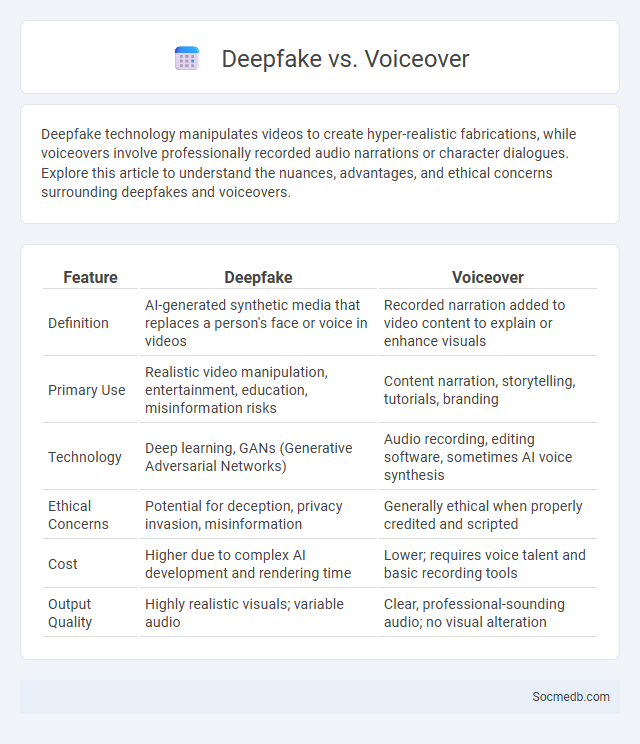
Photo illustration: Deepfake vs Voiceover
Deepfake technology manipulates videos to create hyper-realistic fabrications, while voiceovers involve professionally recorded audio narrations or character dialogues. Explore this article to understand the nuances, advantages, and ethical concerns surrounding deepfakes and voiceovers.
Table of Comparison
| Feature | Deepfake | Voiceover |
|---|---|---|
| Definition | AI-generated synthetic media that replaces a person's face or voice in videos | Recorded narration added to video content to explain or enhance visuals |
| Primary Use | Realistic video manipulation, entertainment, education, misinformation risks | Content narration, storytelling, tutorials, branding |
| Technology | Deep learning, GANs (Generative Adversarial Networks) | Audio recording, editing software, sometimes AI voice synthesis |
| Ethical Concerns | Potential for deception, privacy invasion, misinformation | Generally ethical when properly credited and scripted |
| Cost | Higher due to complex AI development and rendering time | Lower; requires voice talent and basic recording tools |
| Output Quality | Highly realistic visuals; variable audio | Clear, professional-sounding audio; no visual alteration |
Introduction: Exploring Deepfake and Voiceover Technologies
Deepfake and voiceover technologies are revolutionizing social media by enabling hyper-realistic audio and video content that challenges traditional media authenticity. These advancements use artificial intelligence and machine learning algorithms to create manipulated recordings indistinguishable from genuine footage, raising concerns about misinformation and digital trust. Understanding how these tools impact your social media experience is crucial for navigating the evolving landscape of online communication and content verification.
What Is Deepfake? Definition and Applications
Deepfake technology uses artificial intelligence to create hyper-realistic but fabricated videos and audio, manipulating appearances and voices to mimic real people. This innovation finds applications in entertainment, advertising, and education, while raising concerns about misinformation and digital security. Understanding deepfakes helps you recognize their potential and mitigate risks in your social media interactions.
Voiceover Technology: An Overview
Voiceover technology in social media enhances content accessibility and engagement by enabling automated narration for videos, podcasts, and live streams. Advanced AI-driven voice synthesis produces natural, human-like audio, allowing creators to reach wider audiences and improve user experience. Your social media strategy can benefit significantly by integrating voiceover tools to deliver dynamic and inclusive multimedia content.
Deepfake vs Voiceover: Key Differences
Deepfake technology manipulates visual and audio content to create hyper-realistic but fabricated representations, often using AI-driven facial synthesis and voice cloning. Voiceover involves human or synthetic narration added to videos without altering the original speaker's likeness, primarily serving purposes like dubbing or explanation. The key differences lie in deepfakes' intent to deceive by impersonation, whereas voiceovers enhance content clarity without falsifying identity.
Advances in AI: The Evolution of Deepfake
Advances in AI have revolutionized social media through the evolution of deepfake technology, creating hyper-realistic synthetic videos and images that challenge authenticity. This innovation leverages neural networks and generative adversarial networks (GANs) to manipulate visual content with unprecedented precision. Understanding the impact of deepfakes on your digital presence is crucial for navigating trust and verification in the online environment.
Authenticity and Ethics: Comparing Deepfake and Voiceover
Deepfake technology manipulates digital content to create highly realistic but fabricated images or videos, raising significant ethical concerns regarding authenticity and misinformation on social media platforms. Voiceover, by contrast, involves narrating or dubbing content without altering the original visual material, thus maintaining a higher level of ethical transparency. The distinction lies in user trust implications, where deepfakes risk eroding credibility, while voiceovers can enhance accessibility and content engagement without deceptive intent.
Use Cases: Media, Entertainment, and Beyond
Social media platforms revolutionize media and entertainment by enabling real-time content sharing, audience engagement, and personalized experiences that drive user interaction and brand loyalty. You can leverage these channels for influencer marketing, live events, and interactive storytelling, creating immersive experiences that extend beyond traditional media boundaries. The impact of social media spans industries, enhancing customer support, e-commerce, and education through targeted communication and community building.
Security Risks and Misuse: Deepfake vs Voiceover
Social media platforms face increasing security risks as deepfake technology enables the creation of highly realistic but fake videos that can deceive users and spread misinformation. Voiceover misuse involves manipulating audio clips to impersonate individuals, leading to potential fraud, identity theft, and privacy breaches. Protect Your online presence by remaining vigilant against suspicious content and using verification tools to detect synthetic media.
Future Trends in Deepfake and Voiceover
Advancements in deepfake technology are driving more realistic and accessible synthetic media, revolutionizing content creation and posing new challenges for misinformation detection. Voiceover applications are increasingly powered by AI with enhanced naturalness and emotional expression, enabling personalized and multilingual audio content at scale. Emerging regulatory frameworks and AI ethics standards are prompting the development of verification tools and authentication protocols to maintain trust in digital communications.
Conclusion: Choosing Between Deepfake and Voiceover
Choosing between deepfake and voiceover technologies depends on the intended use and ethical considerations within social media content creation. Deepfake offers hyper-realistic visual manipulation suitable for entertainment and marketing but carries risks of misinformation and privacy breaches. Voiceover remains a safer, more transparent option for authentic storytelling and advertiser trust.
 socmedb.com
socmedb.com